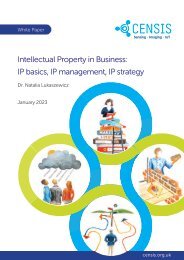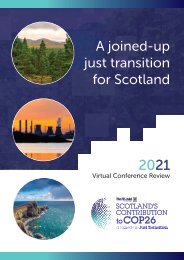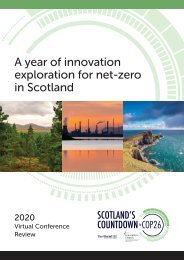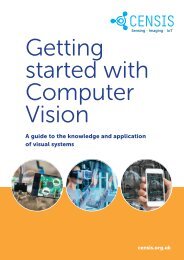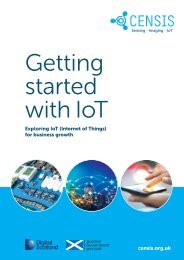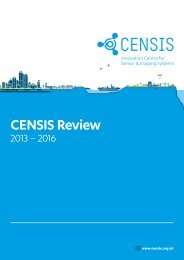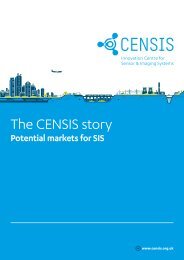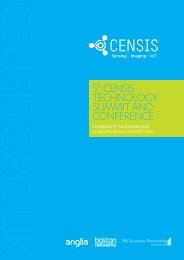Getting started with IoT for Social Infrastructure
How to understand buildings using IoT (Internet of Things). Understanding how our social infrastructure (schools, hospitals, public buildings, housing) performs in real-time will provide unprecedented opportunities to increase efficiencies and improve the wellbeing of users while reducing energy and carbon emissions. Secure IoT solutions can provide new capabilities to connect our physical buildings to digital models and analytical tools.
How to understand buildings using IoT (Internet of Things).
Understanding how our social infrastructure (schools, hospitals, public buildings, housing) performs in real-time will provide unprecedented opportunities to increase efficiencies and improve the wellbeing of users while reducing energy and carbon emissions. Secure IoT solutions can provide new capabilities to connect our physical buildings to digital models and analytical tools.
Create successful ePaper yourself
Turn your PDF publications into a flip-book with our unique Google optimized e-Paper software.
f) Direct BMS integration<br />
Many buildings are fitted <strong>with</strong> management systems,<br />
sometimes running state-of-the-art technologies alongside<br />
legacy equipment that may be outdated or no longer in<br />
production. One of the major challenges of building automation<br />
is to integrate these different systems to ensure they can<br />
communication <strong>with</strong> each other. BMS systems are increasingly<br />
starting to open-up application programming interfaces (API)<br />
which allows developers and estate managers to connect<br />
various systems. Data from an <strong>IoT</strong> gateway can be integrated<br />
directly to a BMS through a data transfer protocol - or data may<br />
be able to be integrated through software integration. There has<br />
also been an evolution of the BMS communication standards<br />
such as such as BACnet that now includes new web standards<br />
to interface into systems and increase interoperability.<br />
g) Whole life per<strong>for</strong>mance framework and <strong>IoT</strong><br />
Improving how our social infrastructure per<strong>for</strong>ms across<br />
the asset lifecycle is a key enabler to support Scottish<br />
Government achieving its ambition of a sustainable and<br />
inclusive net zero carbon economy. This ambition is relevant<br />
to both our new and existing infrastructure as highlighted<br />
by the <strong>Infrastructure</strong> Commission <strong>for</strong> Scotland in its<br />
30-year infrastructure strategy report, ‘Key Findings Report -<br />
A blueprint <strong>for</strong> Scotland’ published in January 2020:<br />
“Most of the underlying infrastructure that will be used in<br />
30-years’ time already exists today. It is there<strong>for</strong>e essential<br />
that these assets are most effectively and efficiently utilised,<br />
maintained and enhanced to net zero carbon readiness.”<br />
How we measure the per<strong>for</strong>mance of our assets across the<br />
lifecycle is a complex and sometimes siloed approach where<br />
data and methodologies differ across regions, sectors and<br />
disciplines. Scottish Futures Trust has led in the development<br />
of research to look at best practice across industry in how<br />
the per<strong>for</strong>mance of social infrastructure is measured across<br />
areas such as commercial per<strong>for</strong>mance, design per<strong>for</strong>mance,<br />
environmental, social & economic per<strong>for</strong>mance.<br />
The ability to measure per<strong>for</strong>mance in a consistent way where<br />
real time data is generated and analysed offers significant<br />
potential. <strong>IoT</strong> technology will help realise the potential sooner<br />
and in a more consistent and in<strong>for</strong>med way.<br />
Areas where <strong>IoT</strong> and cloud-based control systems could<br />
have an impact on whole life per<strong>for</strong>mance:<br />
• Energy efficiency – HVAC, temperature control,<br />
energy automation<br />
• Asset management and optimisation<br />
• Predictive maintenance<br />
• Indoor air quality<br />
• Green buildings standards<br />
• Measurement and verification of per<strong>for</strong>mance<br />
• Real time data<br />
• Compliance<br />
h) Benefits of using <strong>IoT</strong> <strong>with</strong>in our social infrastructure<br />
<strong>IoT</strong> has the potential to digitally trans<strong>for</strong>m how many<br />
aspects of how social building estates are managed.<br />
Benefits are:<br />
Public Services<br />
• Support operational per<strong>for</strong>mance of our public buildings<br />
• Improve building user engagement and experience of<br />
our social infrastructure.<br />
• Improve educational and health outcomes.<br />
Asset Owners<br />
• Improve utilisation of building assets<br />
• Reduce costs in how we manage our assets.<br />
• Improve resilience<br />
• Support operational decision making <strong>with</strong> improved<br />
data analytics<br />
• Support carbon per<strong>for</strong>mance and support Scottish<br />
Government net-zero carbon ambition.<br />
<strong>Social</strong> & Economy<br />
• Create marketplace and opportunities <strong>for</strong> <strong>IoT</strong> providers.<br />
• Support digital marketplace, innovation and<br />
trans<strong>for</strong>mation.<br />
• Support international competitiveness of SMEs developing<br />
<strong>IoT</strong> devices.<br />
• Identify <strong>IoT</strong> solutions to challenges <strong>with</strong>in social<br />
infrastructure supporting business competitiveness.<br />
17





